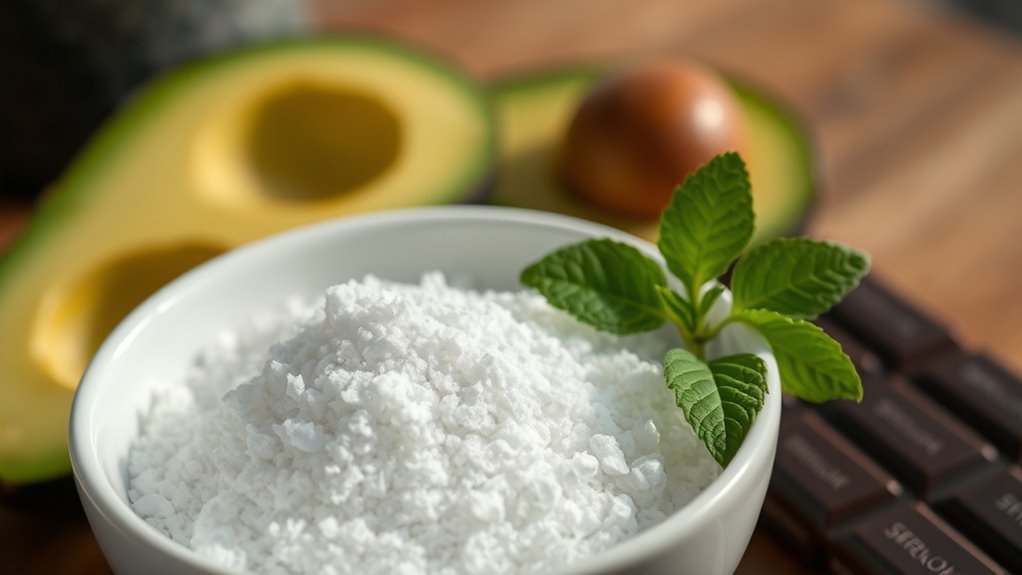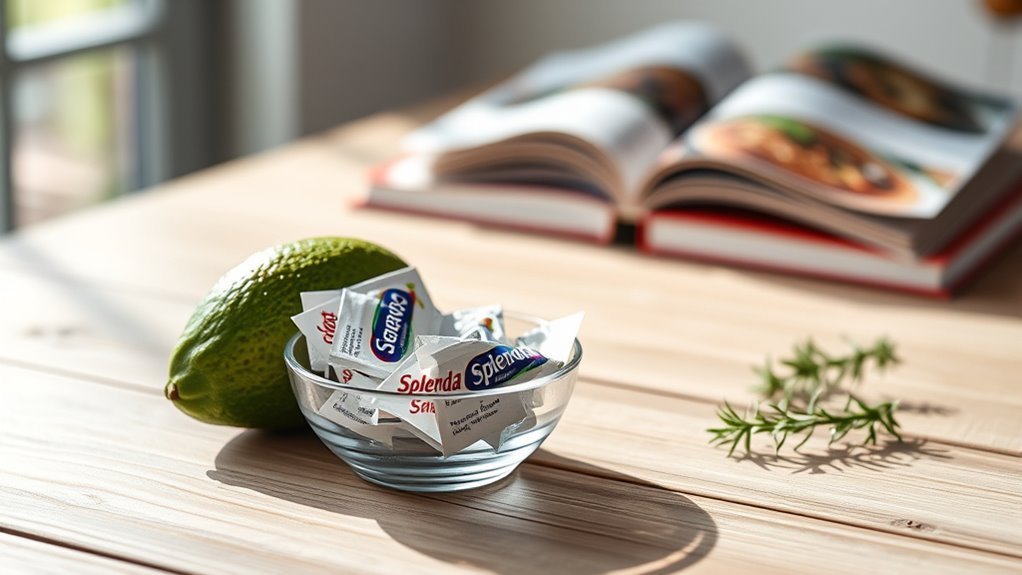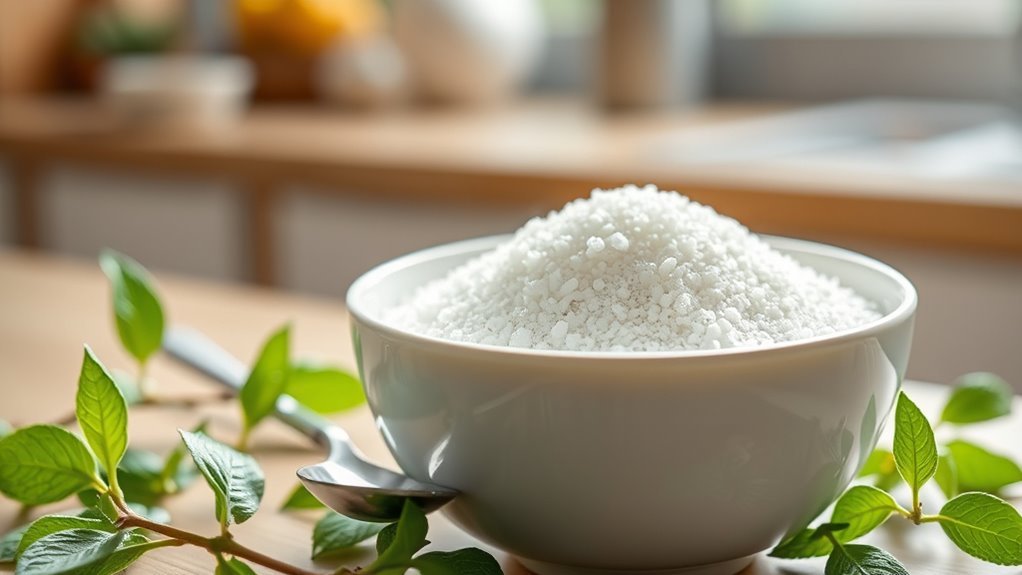Splenda, primarily made from sucralose, is generally considered keto-friendly due to its minimal impact on blood sugar levels. It contains negligible calories and carbs, making it a suitable option for those on a ketogenic diet. However, individual responses can vary, so moderation is key to avoid potential cravings or digestive issues. To better understand how to incorporate Splenda into your keto lifestyle and its overall effects, you might want to explore more details.
Understanding Splenda: Ingredients and Composition

Although many people turn to Splenda as a sugar substitute, understanding its ingredients and composition is vital for anyone considering it on a keto diet. The primary ingredient in Splenda is sucralose, a chlorinated derivative of sucrose. While this might sound appealing, the ingredient breakdown reveals that it also contains dextrose and maltodextrin, which can contribute to net carbs. If you’re exploring Splenda alternatives, be cautious, as not all are created equal. Some may contain fillers that add carbs, undermining your keto goals. It’s important to analyze labels carefully to guarantee you’re making informed choices. Ultimately, knowledge is your best ally in maintaining freedom within your dietary journey, allowing you to navigate sweeteners with confidence.
The Role of Sucralose in Splenda

When considering sweeteners for a keto diet, it’s vital to understand the role of sucralose in Splenda, as it greatly influences the product’s overall impact. Sucralose, an artificial sweetener, is about 600 times sweeter than sugar, which means you need only a tiny amount to achieve the desired sweetness without adding significant calories. Your body doesn’t metabolize sucralose in the same way it does sugar; most remains unabsorbed, leading to minimal impact on your metabolism. This characteristic makes it appealing for those looking to maintain ketosis while enjoying sweet flavors. However, individual reactions to artificial sweeteners can vary, so it’s important to monitor how your body responds to guarantee it aligns with your keto goals.
Impact of Splenda on Blood Sugar Levels

How does Splenda affect your blood sugar levels? When you consume Splenda, which is primarily made of sucralose, studies indicate it doesn’t considerably impact your blood sugar or insulin response. Unlike sugar, Splenda’s zero-calorie nature means it doesn’t raise your blood glucose levels, making it a popular choice for those monitoring their sugar intake. Research shows that sucralose passes through your digestive system without being metabolized, so it doesn’t convert into glucose. However, individual responses can vary, and some may experience slight insulin responses. It’s essential to monitor how your body reacts, especially if you’re managing diabetes or following a keto lifestyle. Overall, Splenda can be a suitable sugar alternative for maintaining stable blood sugar levels.
Can Splenda Affect Ketosis?
While many people on a keto diet are concerned about the impact of sweeteners on ketosis, Splenda, which contains sucralose, is generally considered keto-friendly. It’s important to note that individual responses can vary, especially regarding sweetener sensitivity. Here’s what you should consider:
- Splenda doesn’t considerably raise blood sugar levels.
- It has minimal calories and carbs, making it suitable for keto.
- Some may experience gastrointestinal issues, affecting ketosis duration.
- Monitoring your body’s response can help you understand your sensitivity.
- Overconsumption might lead to cravings for sweets, potentially disrupting your keto journey.
Ultimately, if you enjoy Splenda in moderation and pay attention to how your body reacts, it can be a viable option on your keto path.
Comparing Splenda With Other Sweeteners
When you’re considering sweeteners on a keto diet, it’s essential to compare options like Splenda, Stevia, and Erythritol. Each has its unique properties and potential impacts on blood sugar levels and ketosis. Understanding these differences can help you make informed choices that align with your dietary goals.
Splenda vs. Stevia
Splenda and stevia are two of the most popular sweeteners on the market, each boasting unique properties that cater to different dietary needs. While Splenda, a sucralose-based sweetener, offers convenience, it does have some drawbacks, including potential digestive issues for some people. On the other hand, stevia, derived from the Stevia rebaudiana plant, presents several benefits.
- Natural origin
- Zero calories
- No impact on blood sugar
- Antioxidant properties
- May aid in weight management
When considering these sweeteners, it’s essential to weigh Splenda’s drawbacks against stevia’s benefits. If you’re looking for a more natural, health-conscious choice, stevia may be the better option for your keto lifestyle.
Erythritol Comparison
Choosing the right sweetener for a keto diet involves understanding the differences between various options, including erythritol. Erythritol is a popular choice due to its low-calorie content and minimal impact on blood sugar levels. However, it has both benefits and drawbacks to evaluate.
| Sweetener | Benefits | Drawbacks |
|---|---|---|
| Splenda | Easy to use, widely available | May impact blood sugar |
| Erythritol | Zero calories, natural source | Possible digestive issues |
| Stevia | Natural, no calories | Can have a bitter aftertaste |
| Monk Fruit | Zero calories, no carbs | More expensive, less common |
Ultimately, while erythritol offers significant benefits, including being keto-friendly, you should weigh these drawbacks to find the sweetener that best fits your lifestyle.
Potential Health Concerns of Using Splenda
Although many people turn to Splenda as a low-calorie sweetener, potential health concerns have emerged that warrant careful consideration. It’s important to recognize the health risks associated with long-term use of artificial sweeteners like Splenda, particularly as they may not be as benign as initially thought.
- Possible gastrointestinal issues
- Alteration of gut microbiome
- Increased cravings for sugary foods
- Long-term metabolic effects
- Uncertain links to weight gain
As you weigh your options, keep in mind that while Splenda may help with calorie control, the long-term effects could impact your overall health journey. Staying informed will empower you to make choices that align with your lifestyle and well-being.
Recommended Serving Sizes for Keto Dieters
When managing the keto diet, understanding recommended serving sizes for sweeteners like Splenda is essential for maintaining ketosis. Splenda, primarily composed of sucralose, is low in calories and carbs, making it a popular choice among keto dieters. The general recommended serving size for Splenda is about one packet or one teaspoon, which contains negligible carbohydrates, allowing you to enjoy sweetness without spiking your blood sugar levels. However, moderation is key; consuming excessive amounts could lead to digestive issues or cravings for sweet foods. It’s vital to monitor your overall carb intake, including sweeteners, to stay within your daily limits. By being mindful of these recommended serving sizes, you can enjoy the freedom of flavor while adhering to your keto lifestyle.
Practical Tips for Incorporating Splenda Into a Keto Diet
When incorporating Splenda into your keto diet, it’s essential to use it strategically to enhance your beverages without spiking your carb intake. Consider experimenting with baking recipes that utilize Splenda as a sugar substitute, while keeping portion control in mind to maintain ketosis. By following these tips, you can enjoy sweetness while adhering to your dietary goals.
Sweetening Beverages Strategically
To maintain a keto diet effectively, sweetening beverages with Splenda can be a smart choice, especially since it contains zero calories and carbohydrates. Using Splenda allows you to enjoy your favorite drinks without sacrificing your dietary goals. Here are some practical tips for incorporating this sweetener into your beverage choices:
- Add it to coffee or tea for a delightful morning boost.
- Mix it into smoothies for natural sweetness without the carbs.
- Use it in homemade lemonade or iced tea for a rejuvenating treat.
- Sweeten sparkling water for a guilt-free soda alternative.
- Experiment with it in cocktails for a low-carb drink option.
Utilizing Splenda as a sweetener alternative gives you the flexibility to enjoy beverages while sticking to your keto lifestyle.
Baking With Splenda Tips
Baking with Splenda can transform your keto-friendly treats without compromising flavor or texture. To effectively incorporate Splenda, focus on specific baking techniques. Since Splenda is sweeter than sugar, you’ll need to adjust your measurements—typically using about half the amount. This requires careful flavor balancing; consider adding a pinch of salt or vanilla extract to enhance the sweetness and depth of your creations. Additionally, remember that Splenda can affect the moisture content in baked goods, so you might need to tweak your wet ingredient ratios. Experimenting with these adjustments will help you achieve the perfect consistency while keeping your treats deliciously satisfying. With these tips, you can enjoy guilt-free baking that aligns perfectly with your keto lifestyle.
Portion Control Is Key
Although using Splenda can be a great way to satisfy your sweet tooth on a keto diet, portion control remains crucial to maintaining your carbohydrate goals. Practicing mindful consumption guarantees you don’t overdo it. Here are some practical tips for managing portion sizes:
- Start with a small amount and gradually increase to find your sweet spot.
- Use measuring spoons to avoid guesswork.
- Read labels to understand serving sizes and carb content.
- Mix Splenda with other keto-friendly sweeteners for varied flavors.
- Track your intake in a food diary to stay accountable.
Personal Experiences: What Keto Followers Say About Splenda
While many keto followers seek alternatives to sugar, the opinions on Splenda vary greatly among them. Some share personal anecdotes about successfully incorporating it into their diets without impacting ketosis, appreciating its sweet taste while avoiding sugar’s carbs. Others, however, express concerns about potential side effects like digestive issues or cravings triggered by artificial sweeteners. Taste preferences also play a significant role; some find Splenda’s flavor appealing, while others prefer natural alternatives like stevia or erythritol. Ultimately, the decision to use Splenda hinges on individual experiences and health goals. If you’re considering it, monitoring your body’s response is essential, as what works for one person may not be suitable for another. Balance is key on your keto journey.


